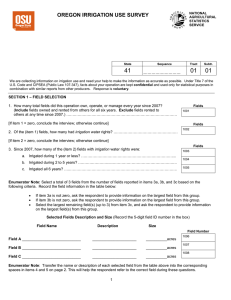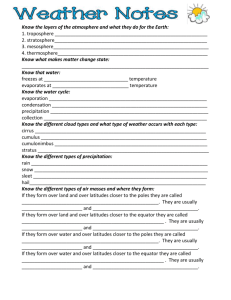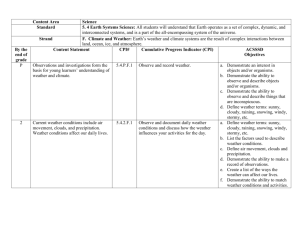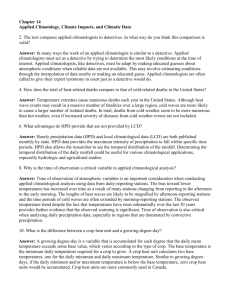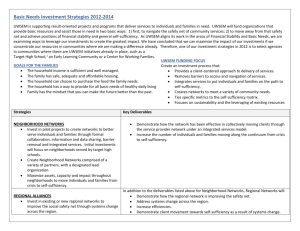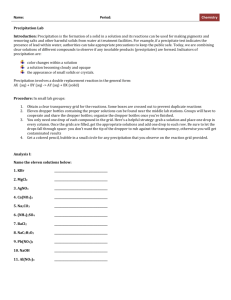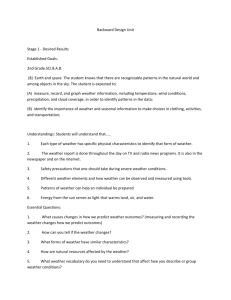Food Security PowerPoint Presentation
advertisement
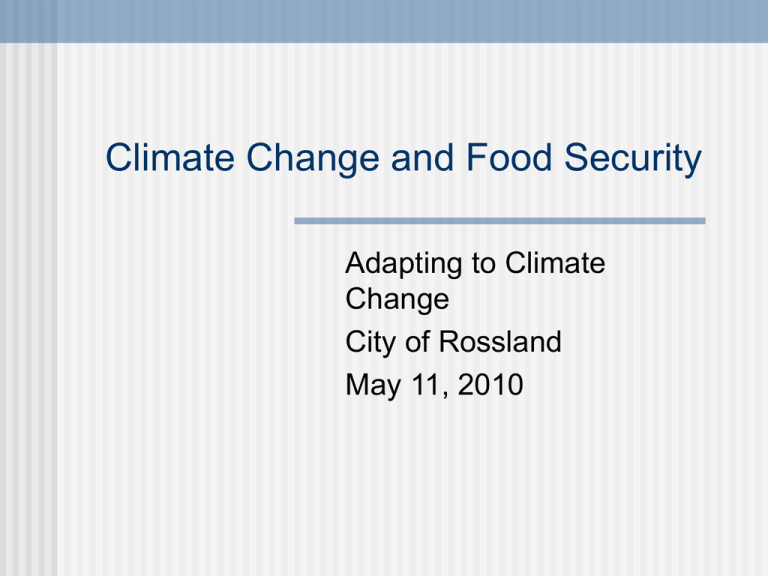
Climate Change and Food Security Adapting to Climate Change City of Rossland May 11, 2010 Food Security “A community enjoys food security when all people, at all times, have access to nutritious, safe, personally acceptable and culturally appropriate foods, produced in ways that are environmentally and socially just.” Four Dimensions to food security: Food availability Food accessibility Food stability Food utilization Food Systems Food Security must be considered through a Food Systems Lens, which includes: food production food processing and packaging food distribution and retailing and food consumption Food systems are highly complex and globalized - in assessing climate change and food security it is not sufficient to analyze domestic production Climate Change and Food Security Types of impacts - climate change will likely have: Timing of impacts Direct impacts - on plant and animal growth and food processing and distribution networks Indirect impacts - on social, economic and political structures Some now, some later Some gradual, some sudden Certainty of impacts Models are highly uncertain Direct Impacts of Climate Change Increased CO2 Concentrations in Atmosphere CO2 fertilization effect may increase crop productivity Ocean productivity could decline due to acidification Higher Temperatures Longer growing seasons and increased productivity in high latitudes as long as temperature increases do not exceed 3° Crop losses and declines in productivity in low latitudes Unpredictable effects in lakes and oceans Less winter kill but increased thermal stress for livestock Possible disruption of transportation lines due to wildfires Direct Impacts of Climate Change (continued) Changes in Precipitation Reduction in arable land in areas with decreased precipitation Challenges capturing water in areas with increased or unchanged precipitation Declines in aquaculture in areas of decreased precipitation Pests and Diseases Little knowledge at this point Earlier spring activity, greater winter survival, and expansion of ranges Direct Impacts of Climate Change (continued) Extreme Events Crop failure or reduced yields Livestock death Disruption of transportation lines Rising Sea Levels Elimination and salinization of arable land in some coastal regions Direct Impacts of Climate Change - Overall Global agricultural production not expected to decline as long as temperature increases do not exceed 3º Significant regional shifts in food production will likely negatively affect developing countries Flaws in the Analysis This analysis does not adequately account for: 1. Indirect effects on social, economic and political structures 2. Non-linear effects or tipping points 3. Climate change temperature increases beyond 3º 4. A major increase in extreme events 5. Non-climate change related events and factors Regional Food Self-Sufficiency BC: 5% of landbase suitable for growing crops Produces 48% of food RDKB and RDCK: 117,367 ha of ALR land 80,589 ha in farms No land class information available but 2/3s considered good 18,027 ha currently in crops Produces less than 48% of food (best guess) Regional Food Self-Sufficiency (continued) Land required to grow enough food: 0.5 ha per person per year (Canada Food Guide) 0.2 ha per person per year (Less meat-centred diet) Amount needed in RDKB and RDCK based on 2006 population: 45,392 ha 4540 ha would have to be irrigated Regional Food Self-Sufficiency (continued) Challenges: 1. Climate change and non-climate change impacts 2. No incentives for new producers/de-skilled population 3. Limited processing and distribution infrastructure 4. Barriers to developing processing and distribution infrastructure 5. Unclear how much land is irrigated or could be irrigated 6. Land class information is needed 7. Some products could not be produced here 8. Seasonality of growing would be a problem

